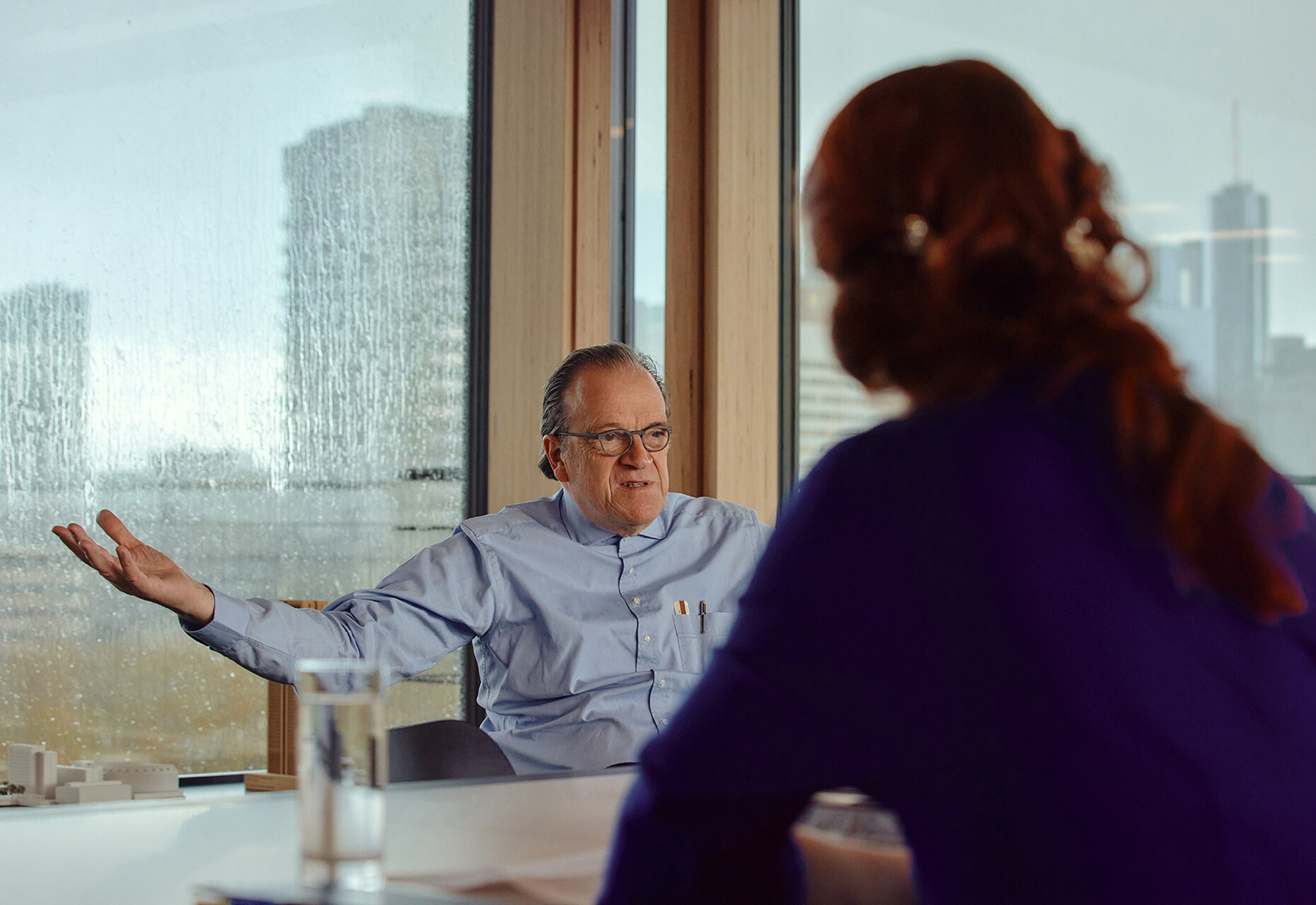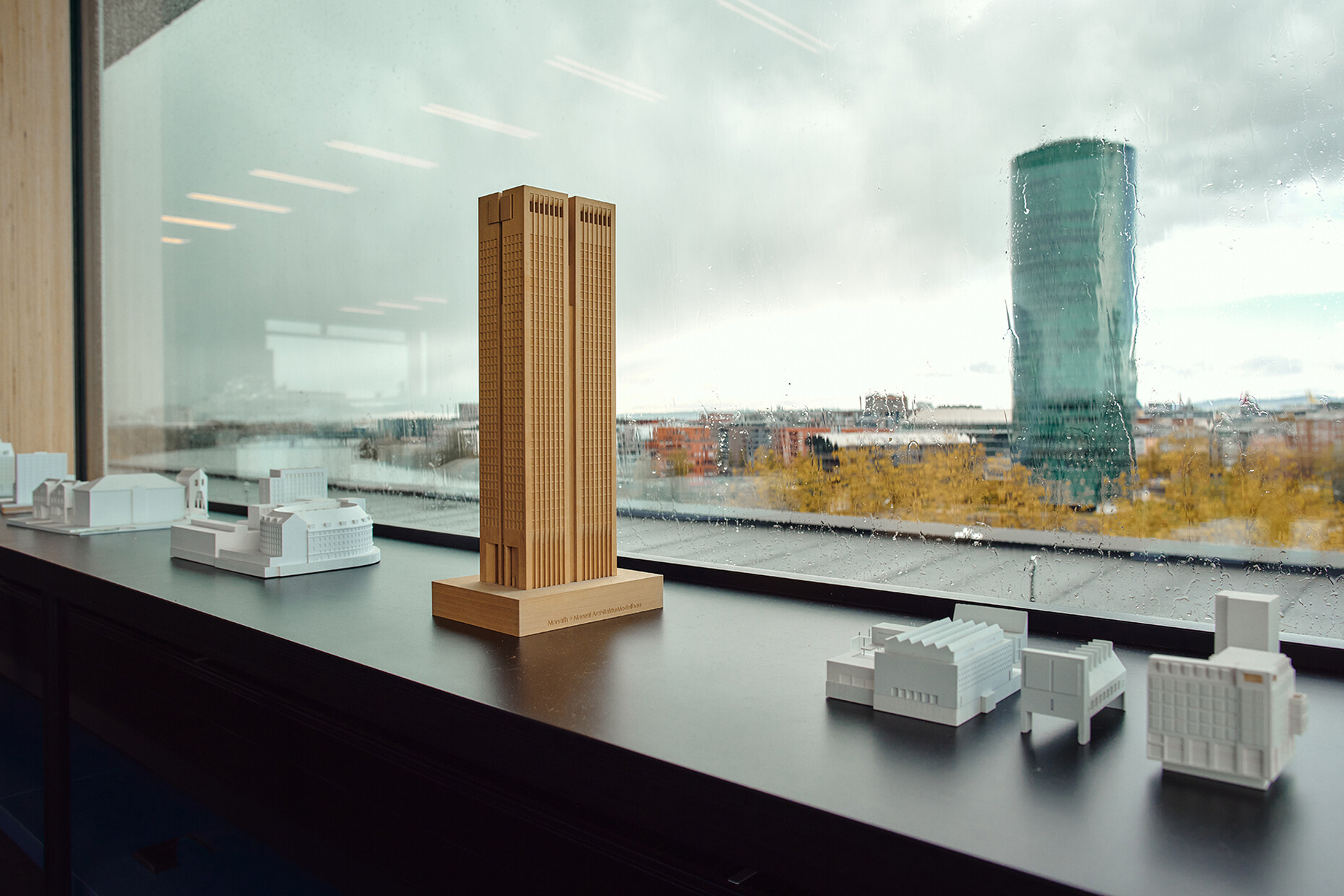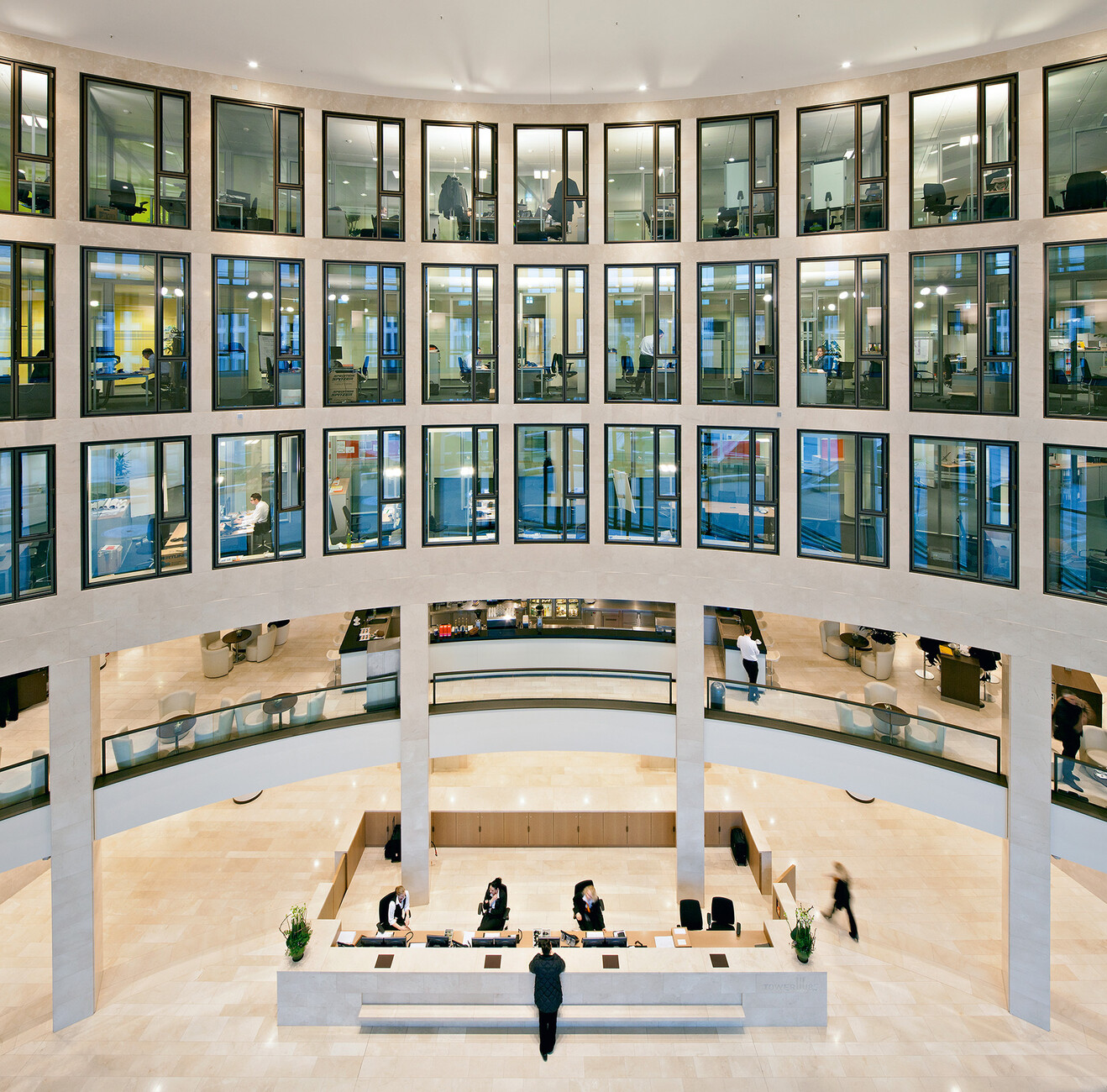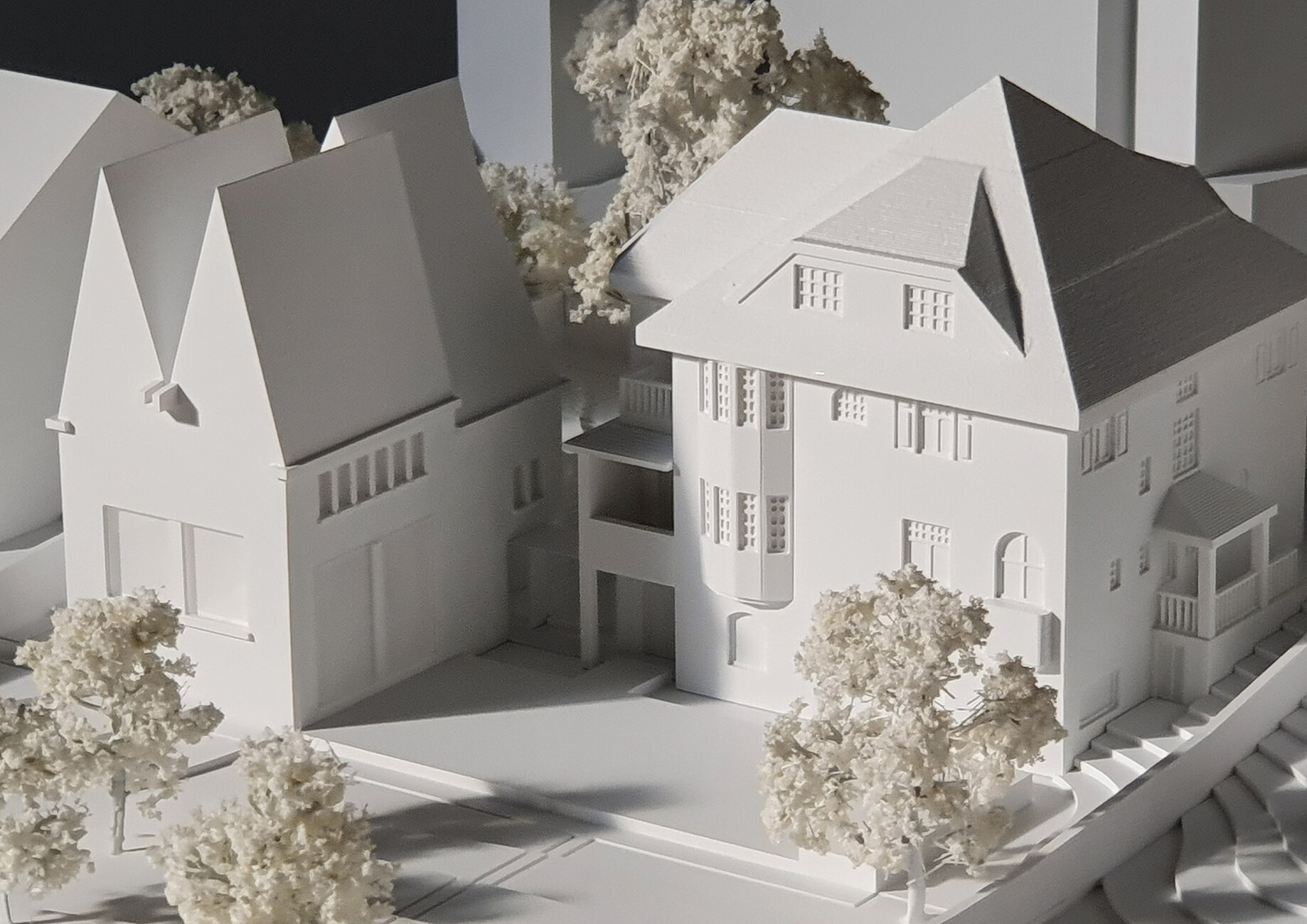The City as an Edifice
Anna Moldenhauer: Prof. Mäckler, In the 10 Grundsätzen zur Stadtbaukunst heute" (10 Principles for Urban Architecture Today) published in 2010 by the Deutsches Institut für Stadtbaukunst (German Institute for Urban Architecture) whose founder and director you are we can read: “The guiding principle of every urban architecture planning in Germany must be that of a sustainable, lasting and attractive building.” What do the terms ‘sustainability’ and ‘beauty’ mean to you specifically in the architectural context?
Prof. Christoph Mäckler: European cities are diverse. It is not about an individual architectural style. What is built and consequently shapes our urban fabric should be so designed that we feel comfortable in it. The thing is to see the city as a structure. Our buildings have to strengthen urban areas, the architecture must improve the place, the square, the street. But we were not taught the requisite urban planning criteria in our training. We have to appropriate this knowledge for ourselves again.
What concepts previously prevailed in city planning aesthetics that are no longer valid today?
Prof. Christoph Mäckler: Cities used to be surrounded by walls, and the available space was limited. Things were built very close together – density is one of the fundamental elements of European cities. After all, where you have density there are also a lot of people, there is life. There were alleys, streets and places between the houses. So, over the centuries it was quite natural for private urban spaces to develop such as courtyards or gardens and public urban spaces in the form of streets and squares. Today, we no longer have these divides. In our new districts what was behind the building in the guise of a courtyard for residential or industrial use, is no longer realized. What is thus the crucial between back and front for urban life, in other words between private (courtyard) space and public street has been largely abandoned and instead we find a mixture. Today, we build “with green spaces” in which we locate our residential buildings. But what is a green space? We had to learn to speak about a boulevard again, an avenue, an urban park, alleys and streets. There are very clear determinants for the various green spaces. We have to redefine our understanding of urban space rather than embracing the ideas of New Architecture and simply continuing a style that is interspersed with green spaces.
In other words, the societal requirements made of architecture have altered.
Prof. Christoph Mäckler: Yes, absolutely.
And you also appreciate aesthetics in urban planning. Why is that?
Prof. Christoph Mäckler: Public space is the social space of our democracy, the city’s living room. At one time façades were suitably adorned and decorated and well proportioned, a house had a clearly recognizable front and back side. The aesthetics resulted in people happily spending time in public areas. Especially during the pandemic there is a markedly greater need for beauty and variety. The European city offers a space with something to be seen and experienced, but it is not uniform, and this is what makes it so attractive.
In the “Düsseldorfer Erklärung zur Reform der städtebaulichen Gesetzgebung” (Duesseldorf Declaration for the Reform of Urban Development Legislation) issued in 2019 you and other high-ranking initiators demand a clear separation of public and private spaces, the good and lasting design of houses, squares, streets, functional diversity, social diversity as well as urban density and the reform of the current urban development legislation. Is that not asking a lot?
Prof. Christoph Mäckler: You are right, there are a lot of points. And that is precisely why European urban development looks so disastrous. For example, we need to prioritize mixed usages. We should stop dividing our towns into industrial estates and residential areas and instead refocus on types of buildings that promote a functional mix. Like a building with two wings and a courtyard – that can be put to industrial or residential use as needed. Today’s new districts no longer offer this flexibility, they are deserted during the day because they typically consist solely of residential buildings. So, it would not be worthwhile opening a café there, for instance. What’s more, given current legal regulations such as the Federal Land Utilization Ordinance and the German Technical Guidelines for Noise Reduction it is hardly possible to realize diverse urban districts any longer.
Add to this the clear distinction between private and public space in the city. If there is a private residential courtyard then families need not necessarily resort to using a public playground. I myself have five children and know what that means. Added to which, social diversity is immensely important; years ago it was quite normal say for a chimney sweep to live next door to a professor. Two completely different social classes lived on the same plot. They were part of a community rather than living cut off from one another. This social diversity is what makes European cities so vibrant.
I find that a nice thought but see it inevitably thwarted by the unavoidable grouping of social classes owing to the different levels of rents and incomes. How can architecture help ensure that all members of society are given the same means of experiencing urban space?
Prof. Christoph Mäckler: I like that question. Years ago, there were different types of buildings for that – so-called houses with wings and courtyards that included every class in society. At the German Institute for Urban Architecture, we are currently developing urban buildings offering say large apartments in the front section and smaller ones in the annex. Given the different sized footprints, the rents are likewise different – and this on its own already makes a social mix possible. That is missing today. Instead we build subsidized housing outside the city center and make all the apartments identical. These houses are shaped like shoe boxes with identical façades. They lack a rear side with an adjoining courtyard or garden that has to be understood as an extension to the living space for the occupants of a building. It can’t be that families are no longer able to find affording housing in the city. And it is important to understand that we need buildings able to cater to different phases of people’s lives. What I am seeing – and this includes my own friends and acquaintances – is a move from the country back to the city once the children are out of the house. The city simply offers more diversity, be it cultural offerings or shopping options.
Another topic of the diverse city is transport. The issue of keeping downtown free of cars, or only permitting a very reduced number of cars is very controversial. What is your opinion on the topic?
Prof. Christoph Mäckler: Here again, the key thing is diversity, all means of transport should be able to enjoy equal rights to using the road. We have to abandon these ideologies. Rather than removing car traffic from entire swathes of the city it would make more sense to introduce a flexible solution. We also ought to alter pedestrian areas again so that they can be opened to cars.
The proponents argue that it [a car-free city] means greater quality of life and better protection of the environment. What is your opinion?
Prof. Christoph Mäckler: I don’t agree with that at all. We simply have to get used to conceiving urban planning over the long term. If I know that given developments in electromobility the combustion engine is on its way out, then I have to plan for this scenario. We can’t waste taxpayers’ money on building new streets every five years. You can get around town quicker by bike than by car but that must not mean private transport should be banned altogether from this space. There are many people who rely on their cars. For example, 80-year-olds don’t generally cycle through cities. And a certain volume of traffic is needed in cities for commerce and to ensure a vibrant setting. Progress can’t be achieved if every transport user insists that they are in the right with their views. Urban life also demands diversity when it comes to modes of transport.
How can architects support social interaction?
Prof. Christoph Mäckler: By planning sensibly. Take a look at Stockholm or Copenhagen; there the streets are designed to suit all transport users while still considering the appeal of urban life. It surely can’t be the solution to simply plaster our roads with markings in red and white paint to indicate transport equality. The city is our social space, our urban living space, and that is something that can’t only be conceived functionally. The beauty of the city is of immense importance. You need a holistic approach, long-term planning and a community spirit.
The idea of downtown areas with fewer cars is already being tested in some European cities, say the closing of the Mainkai to traffic in Frankfurt/Main. How do you view such moves?
Prof. Christoph Mäckler: These are party political ideologies. Removing private transport between the two bridges over the River Main in Frankfurt is questionable because this road is located next to a spacious riverside park with broad paths and quiet areas. Moreover, all the houses there have their entrances at the rear so that their residents do not need to use this section of the road. And it does not help traffic in the city if we close this East-West connection – only the Berliner Strasse still connects the two after the Zeil was turned into a pedestrian area.
What would you propose instead?
Prof. Christoph Mäckler: What I could well imagine is removing heavy traffic, creating wide cycle paths, and also designing the roads to be attractive city streets. The demarcation lines like those on motorways simply encourage car drivers to adopt a faster speed unnecessarily.
Is having too many markings on roads a German phenomenon?
Prof. Christoph Mäckler: Absolutely. That is German planning perfection taken to the extreme, everything has to be 150 percent. In Milan or Paris there are hardly any white stripes on the road compared with German cities yet traffic routing still works. Urban life should not be organized in such a way that only one function is prioritized.
Do you feel the pandemic has altered people’s general ideas about the real nature of urban life?
Prof. Christoph Mäckler: Yes, but not in fundamental urban planning issues. Perhaps the pandemic or climate change will result in the long term in us finally understanding that we need parks and boulevards in cities to produce oxygen. I also think that owing to the new ways people work the use of high-rises will also change over time. If the focus of people’s lives shifts thanks to digitization enabling them to work from home, then companies will also need less rental space. This will reduce traffic in conurbations and over the long term will also alter city infrastructures.
Would you say architects have focused too long on “event” architecture and less on ensuring a design really serves a place?
Prof. Christoph Mäckler: Sadly, yes. At least that goes for some of the so-called star architects. I believe that architecture has to some extent become helpless because it no longer knows how to respond to the urban fabric. This also has something to do with our training methods, which tend to avoid essential know-how. With high-rise buildings, the emphasis cannot be on some spectacular building designs or other that are decisive but rather on the building’s podium. If I have an open design and incorporate other uses, which is what we did for the Opernturm in Frankfurt, then the resulting tower also makes a beneficial contribution to its urban setting. Providing architecture has an urban planning approach it can ensure that urban life actually takes place.
In this context can you think of a recent example of international architecture by one of your colleagues that really impressed you?
Prof. Christoph Mäckler: I consider the Elbphilharmonie by Herzog & De Meuron an excellent example of urban architecture. The use is diverse, aside from the Grand Hall there are hospitality outlets and a hotel. The building stands on its own and moreover, and this is decisive for me, rests on a brick podium that also locates it in Hamburg’s cultural space. As such, the adornment above it is not so decisive and can be event architecture. The architecture has very clearly been designed for the place, it could not be replicated in the same way in Munich or Frankfurt.
While I was doing preparation work for this interview I read that you don’t think much of greening façades or roofs. Why is that?
Prof. Christoph Mäckler: For me that is just window dressing. We can’t seriously believe that we will make our world more ecological by greening the roofs of our buildings. You need open top stories, courtyards with space for large trees to grow that filter the dust from our air and supply us with oxygen. And I find the idea of façade greening ridiculous. Not everyone would like to live alongside mice and spiders. Every city park is more valuable than such greened façades.
Thanks to your many years teaching at the Technical University in Dortmund you are well informed about the urban planning of the densely populated Ruhr region. Is there anything these cities have created that you find exemplary?
Prof. Christoph Mäckler: There are several cities in the Ruhr district that have taken an exemplary approach by seeing the city as a structure to be shaped and not simply as a planning process. Take the man who heads the planning office in Bochum; he is an architect by training and so he has an appreciation of how to plan urban spaces. His department supports this method of designing urban space. He tries to take a new approach by creating urban districts in which people enjoy spending time, that have a certain density, and even boast unsealed courtyards. That is excellent. In Münster, Westphalia I consider the Urban Design Council that I chair and have long been a member of to be exemplary – because local politicians sit on the design council and we all discuss the planning together. I expect politicians to get involved in the planning process for every new urban district. That was the case in Frankfurt for the urban redevelopment of the new Old Town area. However, this participation in the new districts of our cities is often lacking.
You mentioned initially that the basic principles of urban development were not taught back when you were a student and you had to appropriate that know-how yourself by analyzing and studying urban spaces. Is there a city that particularly influenced you during this research work?
Prof. Christoph Mäckler: If I tell you that I’m traveling to Florence then you will know immediately what attracts me most: Not the new district. Sadly, every old town is more attractive than what we are building now. I was very inspired by Europe’s old towns – I studied in Aachen and it has a wonderful old town, a fantastic cathedral and a magnificent city hall. This architecture really impressed me and I asked myself why we no longer design anything like that today. Years ago, every building was striking, today, we design houses like boxes and don’t even let them have different façads.
It is really fascinating to look back in history at how cities have changed as a result of the industrial revolution. Urban planners like Josef Stübben or Camillo Sitte addressed the beauty of the city or wrote manuals for urban development. To my mind, the comprehensive study of the requirements of urban development made at the end of the 19th century was the last of its kind. Which is why for ten years we at the German Institute for Urban Architecture have been working on a manual for urban architecture for which we record and analyze urban spaces, courtyards, squares, streets, describe their character and attempt to show how they can be transferred to the modern age. It is a scholarly study and an attempt to provide architects and planners with the basics that they will need.
You recently celebrated your 70th birthday – looking back is there some insight you have now that you would have like to have had as a young architect?
Prof. Christoph Mäckler: That’s not easy to say. When I started my training people thought differently about urban development than they do today. If I‘d fully realized then what urban development means then I might perhaps have supported it earlier. But changes also mean resistance – our Institute for Urban Architecture was founded 13 years ago and the “10 Principles of Urban Architecture Today", was presented at the Standing Conference on the Beauty and Viability of the City. It wasn’t easy to set that in motion. We talked about the beauty of urban development and in many instances people considered our ideas to be backward looking.
“Beauty” was frowned upon in the architectural context.
Prof. Christoph Mäckler: Exactly. That was only something for the top ten thousand to enjoy. Meanwhile, things have altered fundamentally. In public institutions people now also talk about the beauty of the city.
Why was it so important to you to found the German Institute for Urban Development at Dortmund Technical University?
Prof. Christoph Mäckler: I felt it important that we communicate our scientific research to the public rather than keeping it within the walls of the university. It is incredibly interesting to work with young people and develop new things, to think differently. The institute operates at two different levels: It conducts research, and it also publishes and undertakes urban development policy work say within the framework of the previously mentioned “Düsseldorf Standing Conference on the Beauty and Viability of the City”. Things weren’t easy to begin with but meanwhile this conference brings together heads of planning departments and creates a space for discussion. And my aim was to use our insights to make progress and to prompt a joint change.
You taught for many years at universities and from 1998 to 2018 you had the Chair of Urban Development at Dortmund Technical University. What advice would you give to the coming generation of architects with a view to urban planning?
Prof. Christoph Mäckler: What I always said to my students is that they should follow their strengths and interests, gain a comprehensive education and not let others divert them from their course. It can’t be that only let our students draw one design after another. If we don’t train prospective planners in the basic subjects such as structural theory and building theory then it future we won’t have good urban design, nor the profession of architect. Then we will no longer be needed. So I’m happy that I can detect a great interest in structural theories amongst the younger generation.
As we are on the topic of advice – I have heard that you will shortly be opening an office in Berlin and that your daughter Julia will head it. What advice have you given her?
Prof. Christoph Mäckler: I have always been against trying to influence the career choices of our children and yet my two daughters still decided to study architecture. The office in Berlin, that Julia will head, is not an extension of my office in Frankfurt/ Main. She does not need her father to supervise her. I want her to develop freely and Berlin offers the right environment for that. The city still has niches for creative work.
After completing your studies you could have continued your career in another German city or abroad. What makes Frankfurt/Main so attractive to you that you decided to retain your main focus in the city and to make a decisive contribution to its architectural development?
Prof. Christoph Mäckler: Frankfurt is a fantastic, vibrant and open city where things are within easy reach. I grew up here. When you consider that when I started my training in the early 1970s there was still a wall separating East from West Germany. Munich, Hamburg and other cities lacked the hinterland and consequently the scope for architecture. During my studies I also lived in other cities but thanks to my father’s architecture practice I had more opportunities to work in Frankfurt. And long term I wasn’t interested in international architecture. Frankfurt’s central location ensured our office had enough exciting projects. Maybe I was also lucky.
The focus of our Institute for Urban Architecture on Germany also tends to ensure the formation of a certain resistance against the approach of having uniform architecture internationally. Even in Hamburg I design different buildings than in Frankfurt. If I don’t know or understand the culture of the country then I can’t produce any decent buildings there either. You can hardly take seriously the international projects by so-called international offices because they cannot incorporate the local culture into the architecture. I think first of all you should tackle the problems cities have in their own culture. People like to interpret this conviction as being conservative while I find such a statement to be stuck in the past. Progress does not develop from vague internationality.
What projects are you working on at the moment in Germany?
Prof. Christoph Mäckler: Naturally, as a result of the pandemic everything has got messed up a bit. We are currently working on realizing Terminal 3 at Frankfurt Airport on one of Europe’s largest building sites. In addition, we are working on three museum projects in Freiburg, Frankfurt and Augsburg. The Deutsche Romantikmuseum in Frankfurt/Main will open in the autumn. We have just completed our contribution Oberthürheim to the project "Sieben Kapellen" (Seven Chapels) on the cycle paths in the Danube valley. We are working on several office buildings and hotels in Cologne, Hanover and Frankfurt, partly in conjunction with the heritage authority. In Bochum we are working on a very exciting urban development project that attempts to unite industry and residential on a single plot. We have also restored an electoral chapel in Frankfurt Cathedral that received very little publicity. And naturally we are working on the Römerhof project in Frankfurt where for the first time courtyard houses with industrial courtyards are being installed. We are doing a lot. And our manual on urban architecture as well as a smaller publication on urban design are due to be published soon.
Diversity at all levels.
Prof. Christoph Mäckler: Absolutely.
What is your aim for the next ten years?
Prof. Christoph Mäckler: I hope together with colleagues to be able to develop an urban district that visualizes al the urban issues I have touched on today. A practical example that can serve to test what areas need improving. Meanwhile, the topic of urban development has become a culture in its own right. Now we need to implement the ideas. And that is why I’d like to develop a quarter modeled on these concepts. That is one of my main objectives for the next ten years.





























